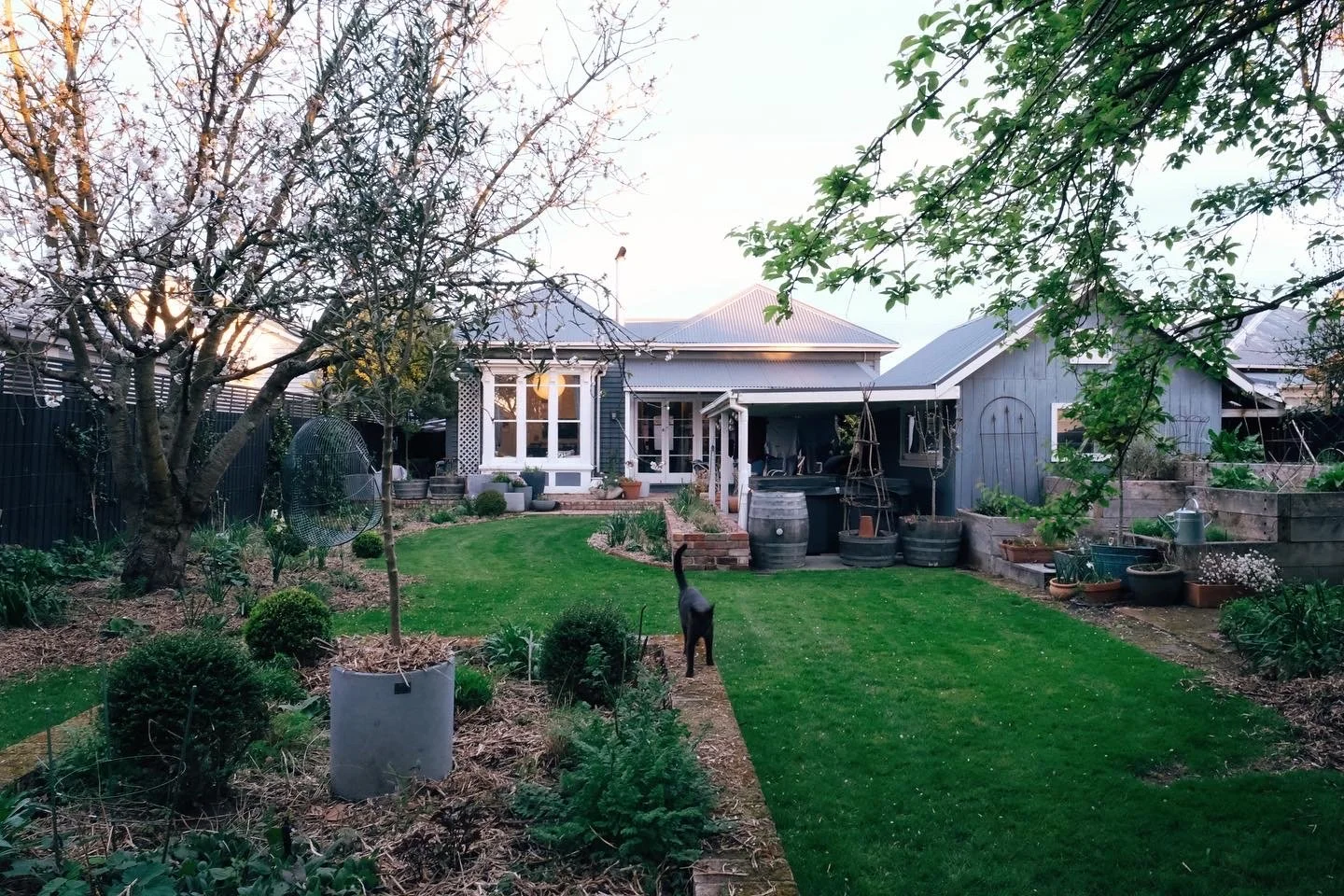Celebrating and lamenting the eager self seeders
/Finally, we have returned to the time of year when the garden begs for multiple visits a day. If the sun is out, and I leave my desk or studio for a drink /lunch/loo, my normal track through the house is extended to enjoy a loop of the garden too. There is so much to see back there and the rapid new growth charges up every part of my existence. Even the odd unseasonal sea-level snow can’t stop me from grabbing at every inch of spring!
My garden in early October 2022.
As the season develops, I have been extra interested to see lush patches of annual Orlaya grandiflora popping up. Also known as White Lace flower, orlaya is a gorgeous umbellifer, broader in petal than its cousins like Queen Anne’s lace and wild carrot. From just three stunted little plants grown from seed a couple of years ago, it seems the dropped seeds have been on their own programme with the first signs of new plant growth revealing themselves in autumn, bolstering up over winter despite the soggy conditions and looking set to flower imminently. This is very surprising to me given the sluggish performance of the few plants I had and absolutely no sign of self-seeded growth last spring for it to now, two years later, be everywhere!
While feeling very grateful that somehow the orlaya has sorted itself out, I’ve been noticing other eager self-seeding residents rising their heads too.
The while umbels of Orlaya peeping through the planting at Barewood Garden.
Providing they were invited in the first place; self-seeding annuals are an absolute gift in my eyes. For those of us that drag our feet a little when it comes to seed raising (that is me I’m afraid to admit), I absolutely relish and welcome the spread of beauties that return their children with little effort.
My sweet pea spot along the sunny fence is throwing up new vines as I write, a continual cycle of fresh, self-generated growth that occurs like clockwork despite not introducing any new plants there for three years now. Similarly, I am on the eye out for sunflower seedlings in my vege garden after enjoying a fabulous self-seeded crop last year.
I see the sporadic patches of larkspur that enthusiastically try to flourish each year, existing now as memories of the only plants I introduced to the garden over five years ago. I never bothered growing them on purpose again as the powdery mildew became boring but, despite that, seeds still find space and reason to have a go. When these plants start to tinge with that all too familiar silver, I simply rip them out with little care.
Forget me nots in my garden where they simply do what they like!
The shadowy end of the garden has a welcome carpet of rambling forget-me-nots. While they were never offered a formal invitation to the property, I find their softness and spread extremely romantic in the crisp brightness of spring. They are punctuated by islands of pink lobelia that seem to have adopted a permanent, self-directed residency in every bright nook and cranny it can find. I have thick fuzzy stands of foxgloves claiming the most awkward of spots, jamming their toes between brick paving and garden edges, but there is no way I can bring myself to pull them out.
I’m also extremely pleased to see the early soft growth of nigella slowly reaching different parts of my borders. It’s taken tree removal and new bed establishment to finally encourage them to take up a bright regular spot and add to the ramble with their beautiful starry blooms. Very pleasingly I have also found signs that my single Cerinthe major a.k.a Honeywort plant from last year is going to return with its offspring. I became quite obsessed with its silvery grey foliage and indigo blue blooms, so am crossing my fingers that more might arrive!
Verbena bonariensis is a welcome self seeding perennial in my garden, but I do find myself having to edit it out a lot!
By nature, self-seeding plants tend to make their own plans, and these are not always in line with the gardeners. Verbena bonariensis might be a slow germinator but it is ridiculously enthusiastic in its strike rate when in the garden. On one hand, this is helpful for replenishing my intentional planting as each established clump is really only healthy for about three years, but it can be too much of a good thing at times. Equally, I love the annual arrival of my nasturtiums but they come with so much gusto and the apparent sole aim to dominate everyone around them. With all of these overachievers, I simply pluck out what I don’t need before their roots get really established.
In contrast, gentle self-seeding perennials like Knautia macedonica, echinacea and geum politely offer me one or two new babies a year, and I simply wait until they are established before plucking out and repositioning to my liking.
My regular crop of self seeded nasturtiums and sunflowers amid other planting in the vege garden.
On the flip side, I have much less fondness for the rampant aggressive spread of my Acanthus mollis AKA Bear’s Breeches which I have tried to banish for a few years but the seed bank is outrageous! They are so difficult to remove with their tough deep roots, I have actually given up to allow them a somewhat controlled piece of space. While I love fennel in my garden, intermingled with perennial planting, I am mostly very stern in thinning out its limbs and immediately removing any developing seed heads. Apparently not stern enough however as a tough crop is currently trying to establish itself in an arid bit of earth and it is almost impossible to pull out with roots intact. That’s why it’s a real concern when you see it growing wild through our river beds!
I have a nostalgic attachment to lemon balm, but would prefer it didn’t want to grow everywhere! With each plant successfully pulled out, another will replace it a few weeks later. And I have really fallen out of love with my self-seeded crop of dahlias. I feel unlucky to have never received anything more interesting than a standard pink, single-petaled specimen so now simply remove any that I haven’t planted myself.
There is obviously a double-edged sword to introducing any keen plant to your garden and a responsibility to avoid letting them escape your borders. But I still prefer editing those that I have once welcomed in rather than swathes of foreign invading weeds that would find space instead.
This is an expanded version of the article featured in my Stuff ‘Homed’ gardening column for beginners , The Press, Dominion Post and other regional papers on October 12th 2022
All words and images are my own, unless otherwise credited.










